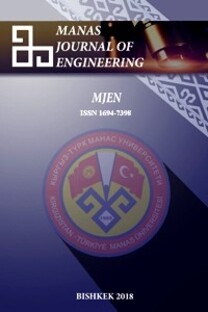Screening Global Challenges And Prospects Facing Medicinal And Aromatic Plants
___
- Iqbal M, International trade in non-wood forest products: an overview. FAO , 1993, Rome.
- Walter S, Non-wood forest products in Africa: a regional and national overview. Les produits forestiers non ligneux en Afrique: un aperçu régional et national. Working Paper/Document de Travail nr. FOPW/01/1, 2001, FAO Forestry Department, Rome.
- Gurib-Fakim A, Molecular Aspects of Medicine, 27 (2006): 1–93.
- Schmincke KH, Medicinal Plants for forest conservation and healthcare. Non- Wood Forest Products 11, Food and Agriculture Organization of the United Nations, 2003.
- Lucy H, Edgar JD, Electronic Journal of Biotechnology, 2(2) (1999): 1-15.
- Cowman MM, Clinical Microbiology Review, 12 (1999): 561-582.
- Adesokan AA, Yakubu MT, Owoyele BV, Akanji MA, Soladoye A, Lawal OK, African Journal of Biochemistry Research, 2(7) (2008): 165-169.
- Schippmann U, Medicinal Plants Significant Trade Study. German Federal Agency for Nature Conservation, 2001, Bonn, Germany.
- Farnsworth NR, Soejarto DD, Global importance of medicinal plants, in: Akerele O, Heywood V, Synge H (eds.), The Conservation of Medicinal Plants. Cambridge University Press, Cambridge, UK, pp. 25–51, 1991.
- Schippmann U, Leaman DJ, Cunningham AB, Impact of Cultivation and Gathering of Medicinal Plants on Biodiversity: Global Trends and Issues. Inter- Department Working Group on Biology Diversity for Food and Agriculture, FAO, 2002, Rome, Italy.
- Pei S, Ethnobotany and modernisation of Traditional Chinese Medicine.
- Shiva V, Protecting our Biological and Intellectual Heritage in the Age of Biopiracy. The Research Foundation for Science, Technology and Natural Resources Policy, 1996, New Delhi, India.
- Moerman DE, Native North American food and medicinal plants: epistemological considerations, In: Prendergast H.D.V., Etkin N.L., Harris D.R. and Houghton P.J. (eds.), Plants for Food and Medicine. Proceedings from a Joint Conference of the Society for Economic Botany and the International Society for Ethnopharmacology, London, 1–6 July 1996. Royal Botanic Gardens, Kew, UK, pp. 69–74, 1998.
- Pei S, Ethnobotanical approaches of traditional medicine studies: Asian Pharmaceutical Botany 39 (2001): 74–79.
- Dev S, Environmental Health Perspectives, 107 (1999): 783–789.
- Desai PR, Golden Resrach Thoughts, 1(6) (2011): 1–4.
- Vorhies F, The global dimension of threatened medicinal plants from a conservation point of view. In: Honnef S, Melisch R, (eds.), Medicinal Utilization of Wild Species: Challenge for Man and Nature in the New Millennium. WWF Germany/TRAFFIC Europe-Germany, EXPO 2000, Hannover, Germany, pp. 26–29, 2000.
- Menges ES, The application of minimum viable population theory to plants. In: Falk DA, Holsinger KE (eds.), Genetics and Conservation of Rare Plants. Oxford University Press, New York, pp. 45–61. 1991.
- Hamilton AC, Biodiversity and Conservation, 13 (2004): 1477–1517.
- Craig S, Himalayan healers in transition: professionalisation, identity and conservation among Tibetan medicine practitioners in Nepal, Paper at a Workshop on Wise Practices and Experiential Learning in the Conservation and Management of Himalayan Medicinal Plants, 2002, Kathmandu, Nepal.
- Misra SS, Classical quality standards in Ayurvedic Medical Sciences.
- Dutfield G, Developing and implementing national systems for protecting traditional knowledge: a review of experiences in selected developing countries. In: Proceedings of Expert Meeting on National Systems and National Experiences for Protecting Knowledge, Innovations and Practices, Geneva, 2003, Switzerland.
- Schippmann UWE, Leman D, Cunningham AB, A comparison of cultivation and wild collection of medicinal and aromatic plants under sustainability aspects. In: Bogers RJ, Craker LE, Lange D, (eds.), Medicinal and Aromatic Plants, Netherlands, pp.75–95, 2006.
- Leaman DJ, Medicinal Plant Conservation, 9(10) (2004): 7–8.
- Walter S, Medicinal Plant Conservation, 8 (2002): 3–9.
- Cunningham AB, Medicinal Plant Conservation, 7 (2001): 21–22.
- Laird SA, Kate K, Linking biodiversity prospecting and forest conservation. In: Pagiola S, Bishop J, Landell-Mills N, (eds.), Selling Forest Environmental Services. Earthscan, London, pp. 151–172, 2002.
- ISSN: 1694-7398
- Yayın Aralığı: 2
- Başlangıç: 2001
- Yayıncı: KIRGIZİSTAN-TÜRKİYE MANAS ÜNİVERSİTESİ
A.d. URDALETOVA, S.n. SKLİAR, S.k. KYDYRALİEV
A.d. URDALETOVA, S.n. SKLİAR, S.k. KYDYRALİEV
- K.A.P.REZAEİEH, - B.GÜRBÜZ, - M.UYANİK
